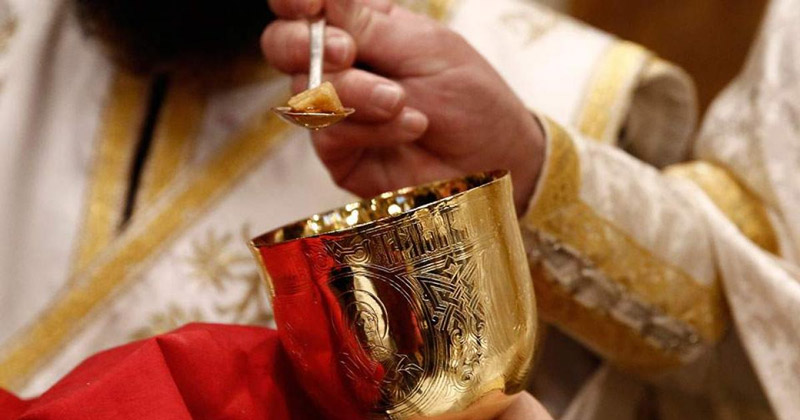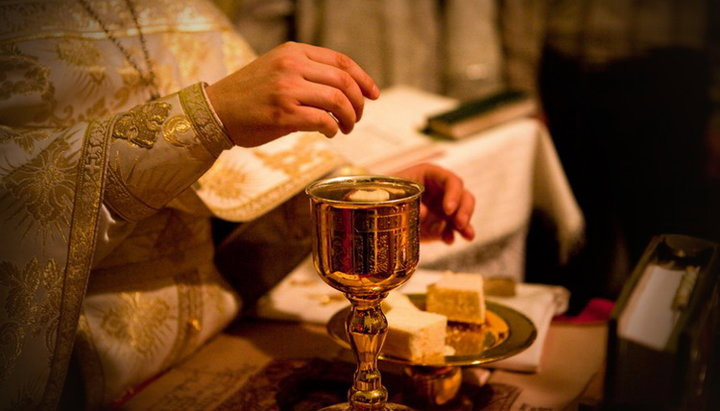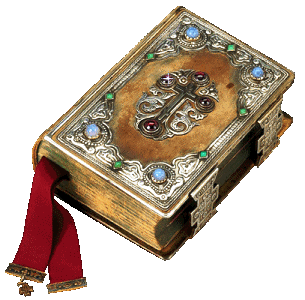- Details

After the reading of the last prayers of the the Service before the divine Communion, the Celebrants come to commune in the prescribed hierarchical order. Each one bows first to his co-Celebrants and then to the people, asking and giving forgiveness. If there is a Bishop, he communes first and then he communes his fellow priests and deacons. First they partake of the Holy Body. The way in which the Priest communes even when he is serving alone has deep symbolism. After venerating the Holy Table, he extends his right palm over the holy Disc, and he takes a small piece of the Holy Body and places it in his open left palm saying: "Unto me, (Name), the unworthy presbyter, is imparted the precious and all-holy Body of our Lord… for the remission of my sins and life eternal." He addresses the given of the Gifts to a third person, from whom it is transmitted to him; and this person is Christ. Christ Himself receives the Priest, as well as then Christ communicates the faithful with the hand of the priest. That is why the priest, when he communicates with every believer, says: "The servant of God receives (name) ...". We also see from these expressions that our Lord Jesus Christ is, as a prayer says, "the Offered and the one who Offers"; that is, He does all things, using us to honor us.
- Details

After the Lord's prayer, which we recite in the Divine Liturgy, the Celebrant blesses the people with the words: "Peace be with all". Truly, how much the Church wishes that the peace of God would guard the hearts of the faithful! After the answer of the people "and with your spirit", the Deacon urges the people: "Let us bow our heads to the Lord.". After the "To You, O Lord", pronounced by the people, while everyone bows before the Holy Gifts, the Celebrant recites the ”Prayer which is read when bowing our heads”. At this moment we bow as a gesture of deep humility and submission to our Almighty and glorious Lord and in honor of the sanctified Bread, which will soon be raised and transmitted to the faithful who have prepared to receive it.
- Details

After the last blessing of the Celebrant at the end of the Holy Anaphora: "And the mercies of our great God and Savior, Jesus Christ, be with you all", the Deacon recites a series of prayers (some of which we have already interpreted in the series of Homilies on the Litanies recited after the Great Entrance).
- Details

Today we will talk about the most central, holy and mysterious part of the Divine Liturgy, during which the Mystery of the Divine Eucharist will take place. Christ offers Himself as a sacrifice for our salvation and the gifts we offered at the Holy Table will be changed into the Holy Body and Blood of Christ. This part of the Divine Liturgy is called "THE ANAPHORA".
- Details

My beloved brothers,
after the Great Entrance, the deacon completes a series of prayers (the Litany of Completion), during which the Priest says in a low voice the Offertory Prayer, in which he asks God to be pleased to accept the Holy Gifts offered for his own sins and for the failings of the people; and for God to reveal the Grace of the Holy Spirit to all of us, and to sanctify the gifts and all the people present. The prayer ends with the exclamation: "Through the mercies of Your only-begotten Son, with Whom You are blessed...".





